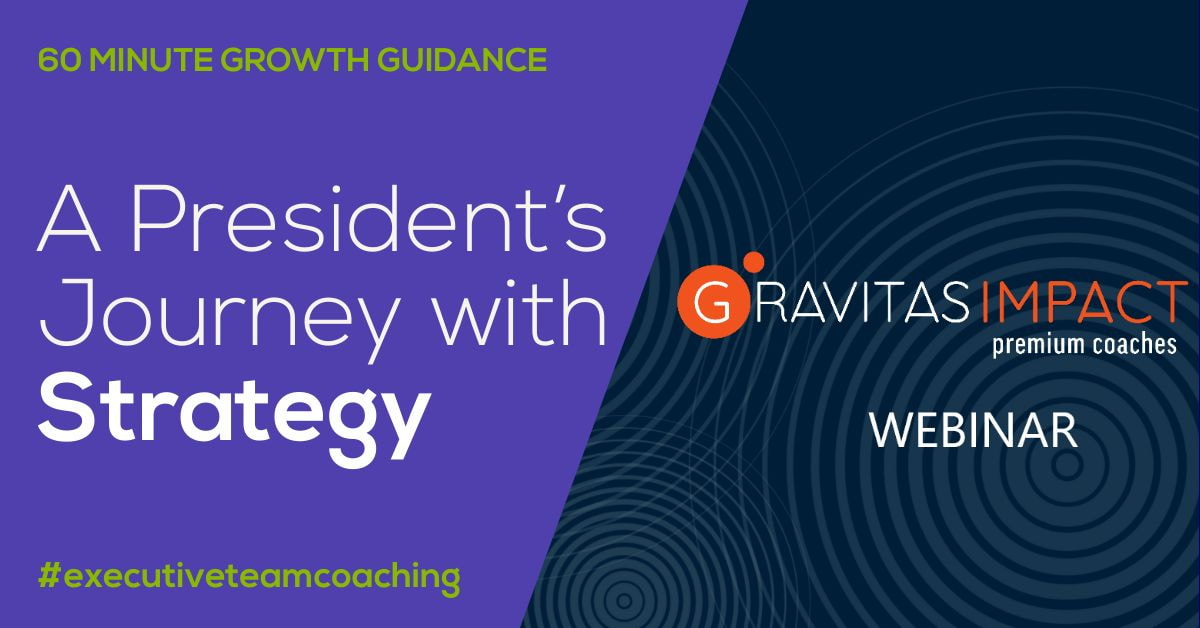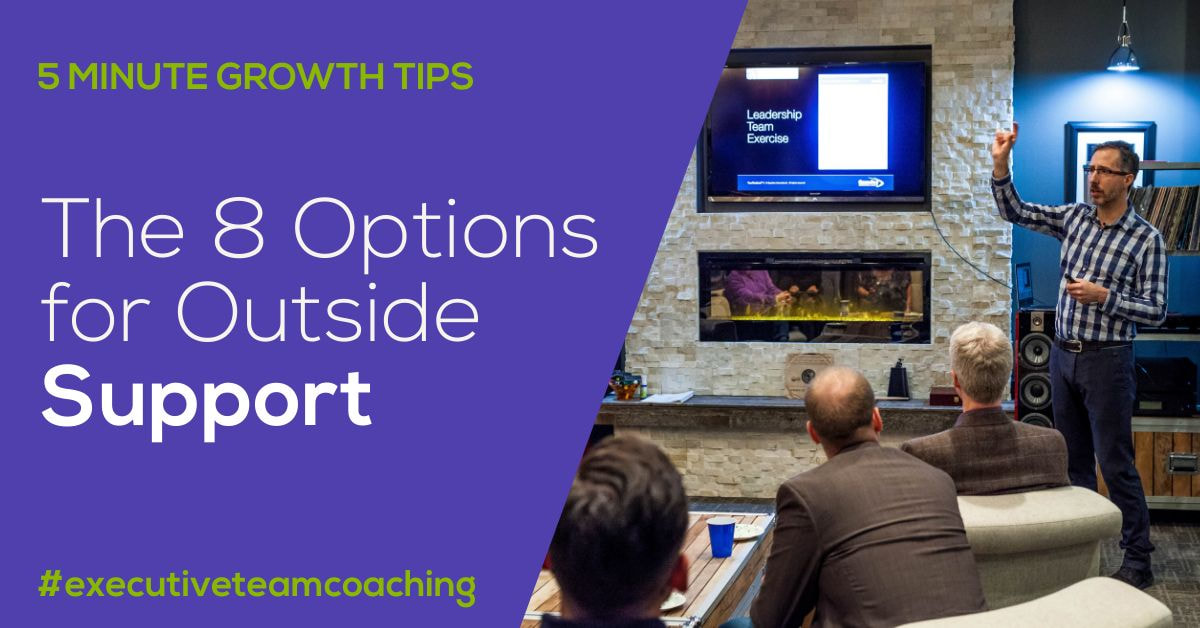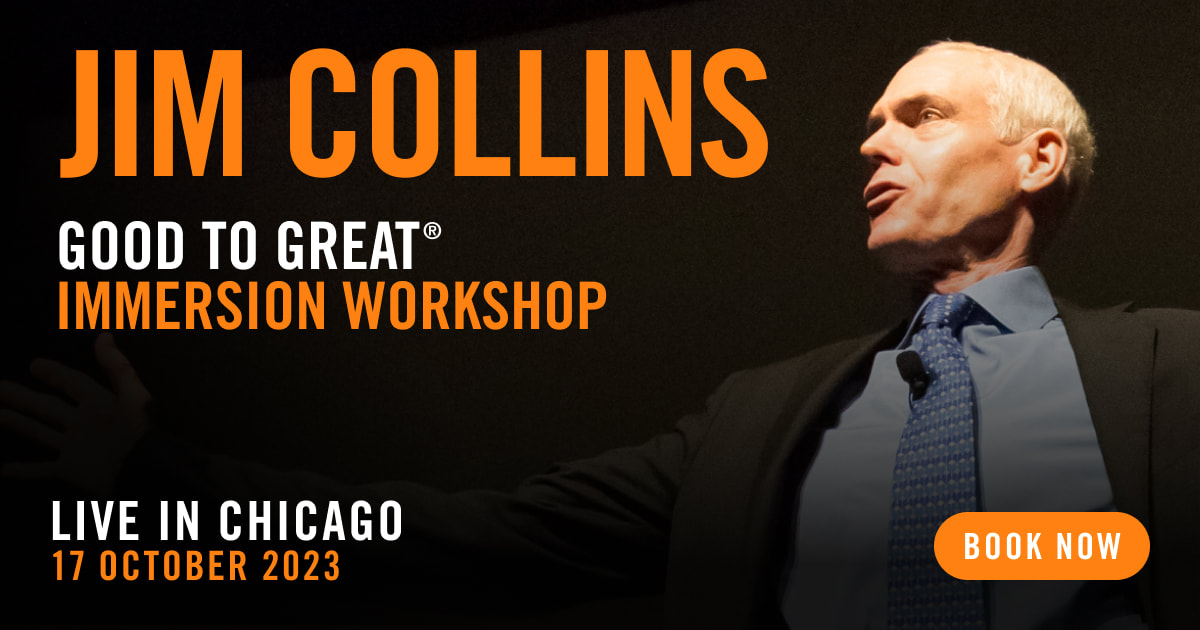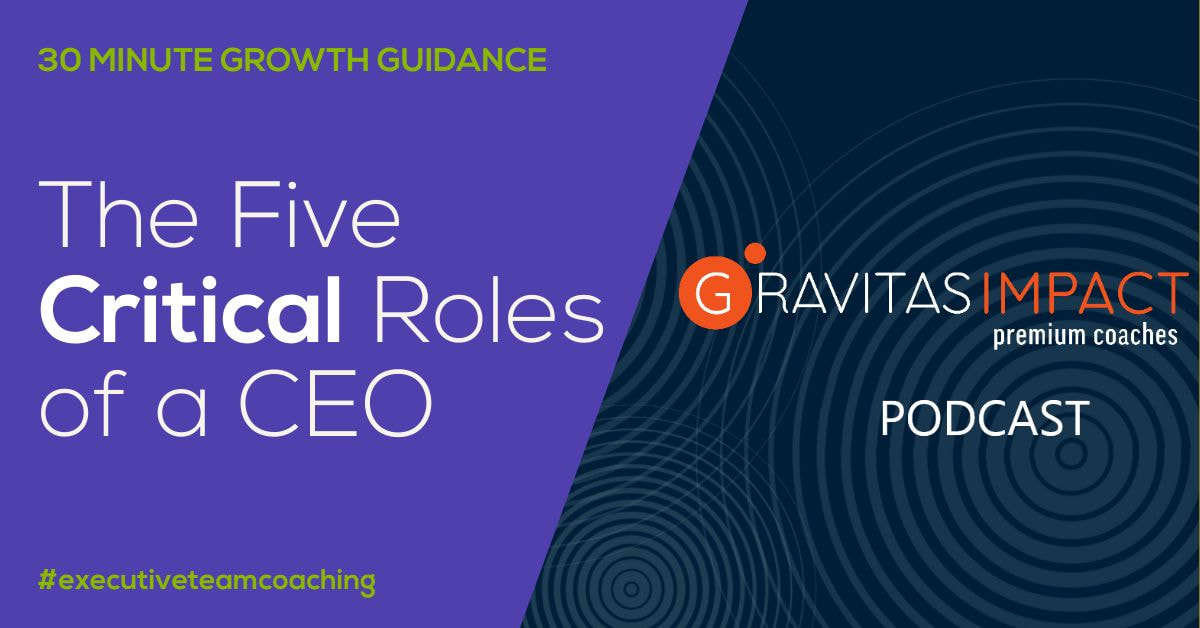|
Most CEOs, presidents and owners I talk to know they need a strategy to guide the business forward. Yet most find it challenging to develop a solid strategy and in a way that gets their whole leadership team aligned around it. In my 19 years experience working with leaders and their senior teams, the biggest mistake is treating strategy development as a one-time event rather than an ongoing process. In this Gravitas Impact Premium Coaches webinar, Mark Bishop, director and general manager of Active Healthcare in Auckland, New Zealand, discusses how the Bishops' family business enjoyed significant improvements in growth, profitability and fun through the process of Radical Alignment to a Core Strategy. Mark is joined by his Gravitas Impact Premium Coach, Leigh Paulden, also in Auckland, to share his perspective on Active Healthcare’s strategy development process. How can you develop a great strategy for your company?
To find out how to build a great strategy to grow more easily, quickly and profitability, AND enjoy the ride, try our complimentary Agile Growth Checklist. This self-service questionnaire takes 5 to 10 minutes to complete. You'll receive the checklist with your responses immediately. Within 24 hours, you'll receive a compiled report highlighting areas to improve. Complete section 3 to check your strategy processes. Or complete all 7 sections to find out how your company is doing in each of the 7 areas needed to produce more rapid, profitable and sustainable growth. This report is complementary and involves no obligation. In the previous 5 Minute Growth Tips article, I wrote about how CEOs can speed up the process of implementing best practices in their leadership team and company by getting outside, help rather than using a Do-It-Yourself approach.
So what kind of services are available and how do they all compare? When evaluating the options, we want to keep in mind the key underlying challenges we want help with to implement the structures, systems and processes needed to grow profitably, and enjoy the ride. These challenges include:
Note that all these challenges involve not just technical changes (eg. how we set goals, run a more effective interview, or put together an effective meeting agenda), but also changes to how we and our leadership team members behave (eg. learning to say no to goals that are important but not top priority, developing the discipline to drill into a job applicant’s past, or practicing the restraint to let all team members speak first). So we’ll want to look for help with both technical and behavioural improvements when we consider the options. Here, we’ll explore the eight most common types of outside support I’ve seen CEOs and business owners consider over my 17 years working with them:
Below, I’ve described each type of service as if it were pure. But they rarely are. There are business consultants who also offer strategic planning facilitation, and HR consultants who also do executive coaching. By reviewing the summaries below you should have a feel for who offers what even if they offer more than one type of service. CEO Peer Forums CEO peer forums are peer groups of CEOs and owners from non-competing companies. They usually meet once a month for a half day to a day. This includes sharing wins and obstacles, hearing other members’ experiences, and sharing goals and commitments to apply what they discovered. In most peer forum meetings, there will also be a presentation from a guest speaker, or from the moderator, on a topic of interest to the group. The Pros: CEOs and owners develop relationships with peers who understand where they are coming from. Being a CEO or business owner can be a lonely job because no one inside the company understands what they’re going through. A CEO forum solves this problem. It can also be a great place for networking. Keep in mind that most CEO forum groups frown upon any kind of sales activities in the group, including asking for referrals and introductions to other business owners. The Cons: While CEOs will hear others’ experiences of how they handled certain situations, they’ll need to keep in mind that the tactics shared may or may not be proven best practices. While an approach may have worked for their CEO peer, it may not work in their own unique environment. Similarly, the tactics shared may have gotten the peer CEO through the situation, but may not have produced excellent results. Members will also want to keep in mind that their own description of the problem will be the basis of the solutions others share. If we don’t fully see our problem, or we’re biased in how we see it, the solutions other members share could be misguided. Without others seeing our situation first hand, there is no way for our CEO peers to be truly objective with the solutions they offer. As well, when a CEO peer forum member is implementing solutions they hear, they then have to convince their leadership team that the problem exists and that the solution they heard will work, because their team members were not part of the discussion. This can lead to hesitation, if not resistance, from their leadership team. Business Consultants Business consultants aim to provide analysis and insights to a CEO or other leader on what needs to change. Business consultants vary from “pair-of-hands consultants”, who are hired to carry out work the company directs them to do, through to “expert consultants”, who review information, meet with team members and provide recommendations for what to change or improve. In between these two types are “collaborative consultants.” They do the same work as expert consultants but work hand-in-hand with the client to gather information and develop recommendations, so the client builds some capability in-house. The Pros: Experienced and effective business consultants can provide insight on a focused problem that is technical in nature, whether it is about business processes, financial management, accounting, marketing activities, or sales processes, in short, within the various functional areas of a business. They can also provide validation for a high stakes decision by gathering more rigorous data and doing a more thorough analysis than the client has the ability or resources to do themselves. The Cons: Business consultants are not often experts at supporting the implementation of their recommendations. I’ve met many business owners who have hired consultants only to have the report still sitting on a shelf, collecting dust. In my experience, there are many more consultants who only make recommendations than those who will stand behind those recommendations to see them through. That said, some consultants will work as contractors to implement new processes or systems, manage and maintain them for a while and then train others in the company to take them over. However, this only works for trainable technical skills as opposed to behavioural skills, which take much more than training. Changes in behavior require the CEO and leadership team to realize that they are part of the problem and that they need to change how they do things. The challenges we’ve been discussing in this 5 Minute Growth Tips article series involve alot of behaviour change. So doing analysis and making a recommendation usually does not work. Instead, we need to get leaders to think about their part in the situation and consider what they personally need to do differently, so that they will take ownership of the solution and change their behavior. While some consultants have this capability, it’s generally not what consultants do. HR Consultants Given that working on our leadership team processes and systems involves changing behaviours, we might consider those we think of as experts on people: HR consultants. They typically take a similar approach to broader business consultants, but focus on the human resource management function. Again, those who use an expert consulting approach will review documents, hold interviews and provide recommendations. Those who use a collaborative approach will do the same, but with the client rather than for them. However, HR Consultants’ will typically limit themselves to HR processes and systems: job design, hiring, orientation, onboarding, training, performance planning and review, compensation, disciplining, dismissal and labor law. Some HR consultants will provide individual or organizational assessment services based on surveys or interviews. And some also provide basic strategic planning services (see below). The Pros: When a CEO or owner is absolutely certain that the main area for improvement in the leadership team is a technical one related to how individuals are found, managed, paid and removed, an HR consultant may be appropriate. However, keep in mind that the solutions again are technical ones, not behavioural. And the growth challenges we have been discussing in this 5 Minute Growth Tip article series are primarily behavioural. The Cons: HR consultants don’t typically support leadership team members to change and improve their behaviours as leaders or team members. Their organizational assessments can be helpful. However, HR consultants will not necessarily pick up on subtle leadership and interpersonal behaviours that could be as or more important factors. Their strategic planning facilitation services often cover the basics of mission, vision and values, with little or no attention paid to competitive market positioning or execution. Strategic Planning Consultants and Facilitators While business and HR consultants provide recommendations, strategic planning consultants and facilitators moderate leadership team discussions to come up with their own solutions, decisions and plans. The “consultant” in “strategic planning consultant” usually means they recommend the process for strategic planning the leadership team will use to make decisions. The strategic planning consultant doesn’t usually recommend what the leadership team should do in their business. Instead they facilitate those discussions and decision-making. The Pros: Experienced, trained, strategic planning facilitators can be great at moderating and guiding conversations to arrive at clear, well thought out decisions with a level of buy-in and commitment from the team. Having an outside, experienced facilitator also frees up the CEO to participate in the conversation rather than trying to lead the meeting effectively while also contributing. The Cons: Many strategic planning facilitators are well versed in the basic planning processes of SWOT analysis (strengths, weaknesses, opportunities and threats), Core Values, Mission, Vision and priorities. However, I have met very few who know how to facilitate competitive strategy decisions and execution planning and monitoring, let alone other key issues that often arise, like role clarity, talent assessments, profitability, cash flow and mindset, just to name a few of the dozens of practices that help with growing a mid-sized company. Team Building Facilitators and Trainers Team building facilitators generally come in three flavors. There are those who do personality assessment sessions, those who lead team building learning activities, and other event and activity businesses who have branched out into this space. Personality assessment sessions have leadership team members learn about each others’ personality types and how to work better together. Team building learning activities include fun, social events intended to bring awareness to basic collaboration skills like listening, communicating, planning, problem solving, etc. Some examples of these activities include team obstacle courses, activities to build objects with unusual materials, or trust falls. Other event and activity businesses, like wall climbing studios, escape rooms and axe throwing centres, also offer their activities for companies looking to do team building. The Pros: Personality assessments are a worthwhile team building activity. By understanding our own and each other’s strengths and weaknesses, preferences and frustrations, leadership team members learn to be open and vulnerable. This often results in a higher level of trust within the team and team members communicating more effectively with others. Team building learning activities and other event and activity companies can be fun for team members, create structured time together in a more relaxed environment, and can remind them of basic team skills. The Cons: The trust and communication skills developed in a personality assessment session can fizzle rather quickly afterwards. This is because these sessions rarely get into the other critical aspects of leadership team collaboration, like having productive conversations and conflict, making clear decisions that all team members are committed to, and holding each other accountable for execution and results. So while personality assessments are good as far as they go, they don’t go far enough. Similarly, the skills identified in team building activities rarely lead to meaningful application within real life decision-making and execution. These activities usually take place in a separate, fun environment or involve role plays. Without application and practice in the challenging realities of the business, the skills won’t stick. Leadership and Executive Coaches When CEOs and owners of mid-size businesses think of a coach, they generally think of an executive or leadership coach. This is someone they would talk to one-on-one on a regular basis who would support them in becoming a stronger leader, in curbing a habit they want to change or achieving an important goal. A leadership or executive coach doesn’t analyse the CEO’s business or recommend solutions. Instead, they guide the CEO in working through the problem themselves. In this way, the CEO reflects on their own part in the challenges they face, takes ownership for it, and works on changing those behaviours to achieve a better outcome. Leadership and executive coaches also hold the CEO or business owner accountable for change, progress and results, given CEOs often have no one to play that role for them. The Pros: Executive and leadership coaches can be a great support to help a leader really move the needle on how they show up, work through problems, interact with others and manage themselves. Leadership and executive coaches also help with execution by supporting the CEO or owner on an ongoing basis. In this way, they guide the CEO through the intricacies and hiccups of making new behaviours stick in the face of day-to-day real-life challenges. Cons: A key limitation of one-on-one executive and leadership coaching is that the CEOs of mid-size companies may often learn things that they want their leadership team members to learn as well. Yet they’ll often find it difficult to teach those concepts to their people themselves. They may then find they have to get the same one-on-one coaching for one or more of their team members. Another limitation is executive and leadership team coaching addresses the individual’s behaviour, but doesn’t fully address the relationships and interactions between the individual and someone else, because the other person’s perspectives and behaviours are not factored in. In a similar way, it doesn’t address the relationships and interactions across a leadership team. Beyond that, leadership and executive coaching tends to focus more on behaviours and less so on the technical business aspects a CEO and leadership team need to also pay attention to, areas like: strategy, execution, systems, customer, profitability and cash flow. Business Coaches Like leadership and executive coaches, business coaches work one-on-one with owners, serve more as problem-solving guides rather than do-it-for-you analysts, and hold them accountable for progress. In contrast to leadership and executive coaches, business coaches tend to focus more on business aspects and less so on leadership behaviours. They often work with owners of small to mid-size companies to guide them through key business decisions. The Pros: A seasoned, trained, certified business coach can be a great resource for owners of small businesses: those who don’t yet have a management team and don’t yet need one. In these businesses, the owner is the key decision maker for every function in the business - from marketing, sales and production, to HR, accounting and IT. Given the multiple areas a business owner needs to pay attention to, an experienced business coach can help them find their way and keep on top of everything. The Cons: Like leadership and executive coaches, business coaches work one-on-one with the business owner. Once a business grows to the point of having or needing a management team (usually around 10 to 20 employees), the business owner will have one or more managers leading certain functions, whether that’s marketing and sales, production, or finance and administration. At this point, the business owner may want these other managers to receive professional guidance from their business coach as well. However, this can lead to problems where decisions made by the owner become disjointed from the decisions made by the other manager(s). This will cause different parts of the business to go in different directions and cause unnecessary conflict, inefficiencies, problems for employees and customers, and subpar performance overall. Business Growth & Executive Team Coaches In the last 10 to 15 years, a new type of coaching service has evolved to meet the needs of mid-sized company CEOs and their whole senior leadership teams. Some of these coaches call their service Leadership Team Coaching. Others call it Business Growth Advisory Services, Business and Leadership Growth Coaching or CEO and Executive Team Coaching. Regardless of the label, this hybrid service includes a combination of regular, ongoing, one-on-one CEO coaching and facilitated leadership team planning and coaching sessions, whether quarterly or monthly. This newer breed of coaching also uses some of the same group facilitation methods as strategic planning facilitators and team building trainers, but with a more holistic set of both leadership and business best practices, so they can support and guide the large majority of decisions and actions a CEO and leadership team need to take on their growth journey. The Pros: With an experienced, trained and certified Business Growth & Executive Team Coach, CEOs and owners of mid-sized companies get many of the benefits of the other options above, with few of the disadvantages. A seasoned Executive Team Coach provides a caring, empathetic, understanding ear because they’ve seen the CEO’s situation many times before. They share and teach proven best practices that have been shown to get results. The whole leadership team learns these best practices and buys into them more easily. Executive Team Coaches act as an outside, objective observer who can point things out that the CEO and team may not be aware of. They support both the technical and business improvements and the behavioural and leadership change needed for the leadership team to truly move forward. Working with the leadership team as a whole enables improved interactions and relationships across the team. They guide the leadership team through critical real-life, real-time decisions and planning, in ways that ensure the whole team is clear, focused and aligned. They enable the CEO to fully participate rather than worrying about running the meetings. They support high level strategic thinking decisions right down to detailed execution planning, accountability and course correction, so that real progress is made. The Cons: Business Growth & Executive Team Coaches are more expensive than leadership, executive or business coaches as well as strategic planning and team building facilitators. This is because of the much greater value they bring in terms of decision-making quality, execution follow-through and business results. It’s also because of the years of business, coaching and facilitation experience needed to be effective guiding a CEO and their whole leadership team. That said, the whole leadership team benefits from the service, not just the CEO. So the investment per person can still be lower than some of the other options above. This kind of service is also not for those who are looking for a quick fix. Recall that growing a company involves both technical and behavioural improvements at all levels of the company, within every department, and across a number of different areas: leadership, talent, strategy, execution, cashflow, customer, systems. It takes ongoing focus, commitment and discipline to implement the many best practices needed to grow and profitably. And so business growth advisors and leadership team coaches provide the ongoing support for CEOs and their leadership teams to lay the foundation and build from there over time. For CEOs and owners of mid-sized companies who’ve recognized a Do-It-Yourself approach is too slow and are looking for outside support and guidance, there are a number of options to choose from. However, in my experience, to see real improvement, progress and results within themselves, across their leadership team and down through their organization, Business Growth & Executive Team Coaches offer the best investment to grow profitably and enjoy the ride. While an Executive Team Coach may be best for you and your company. Will you be a good fit for them? In my next article, I’ll share what it takes to be successful with a Business Growth & Executive Team Coach. How can you grow a thriving company? To find out what to focus on to to grow more easily, quickly and profitability, AND enjoy the ride, try our complimentary Agile Growth Checklist. This self-service questionnaire takes 5 to 10 minutes to complete. You'll receive the checklist with your responses immediately. Within 24 hours, you'll receive a compiled report highlighting areas to improve. Find out how your company is doing in each of the 7 areas needed to produce more rapid, profitable and sustainable growth. This report is complementary and involves no obligation. A ROAD MAP TO WHAT MAKES GREAT COMPANIES TICK For the first time ever, Jim Collins presents a full-day workshop LIVE in Chicago. Bring your team, join an exclusive group of executive leaders, highly motivated to implement the time-tested, research based, practical framework of Good to Great® and Jim’s full body of work. (Only 500 places available!) One of the 100 Greatest Living Business Minds (Forbes), Jim Collins knows what it takes to make a company not only survive but thrive. In this highly interactive, full day seminar Jim distils three decades of research into one single road map for building a great company. Your team will be equipped to critically assess your business, face the brutal facts and align your business strategy for success in an ever-changing market. Elevate your leadership, increase company-wide discipline, drive transformational business growth. “Greatness is not a function of circumstance. Greatness, it turns out, is largely a matter of conscious choice, and discipline.” Jim Collins Why do some companies triumph and achieve long-term success while others fail? How can mediocre companies achieve greatness? Join Jim Collins and a group of passionate leaders to forge a road map to greatness. Designed for CEOs, executive teams and lifelong students of Jim’s work, don’t miss this rare opportunity to learn directly from powerhouse, Jim Collins, in a space designed for deep learning, strategising, and team discussions on application and implementation. “Will you settle for being a good leader, or will you grow to become a great leader?” Jim Collins How can you develop your leaders?
To find out how to develop your leaders to grow more easily, quickly and profitability, AND enjoy the ride, try our complimentary Agile Growth Checklist. This self-service questionnaire takes 5 to 10 minutes to complete. You'll receive the checklist with your responses immediately. Within 24 hours, you'll receive a compiled report highlighting areas to improve. Complete sections 1 and 2 to check your company’s leadership and people processes. Or complete all 7 sections to find out how your company is doing in each of the 7 areas needed to produce more rapid, profitable and sustainable growth. This report is complementary and involves no obligation. With the CEOs we work with, we often have them take a hard look at what roles they need to delegate to focus less on the day-to-day and more on growing their company. These can include functions like marketing, sales, finance, accounting, operations, human resource, information technology. However, they are then faced with the question of what their role should be instead. In this Gravitas Impact Premium Coaches podcast, my colleague and author Brad Giles, in Perth, Australia, uncovers the five roles a CEO must play for their mid-size company to consistently achieve great results. Subscribe to Gravitas Impact podcast: Android
How can you grow a thriving company? To find out what to focus on to grow more easily, quickly and profitability, AND enjoy the ride, try our complimentary Agile Growth Checklist. This self-service questionnaire takes 5 to 10 minutes to complete. You'll receive the checklist with your responses immediately. Within 24 hours, you'll receive a compiled report highlighting areas to improve. Find out how your company is doing in each of the 7 areas needed to produce more rapid, profitable and sustainable growth. This report is complementary and involves no obligation. |
Archives
December 2029
Categories
All
|






 RSS Feed
RSS Feed
